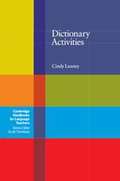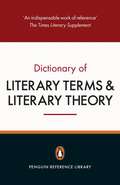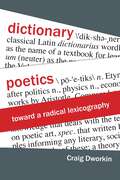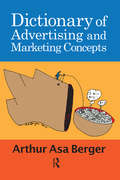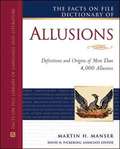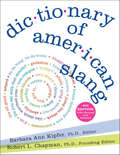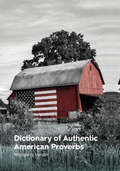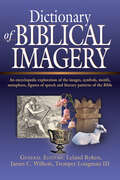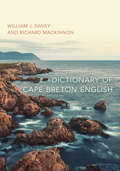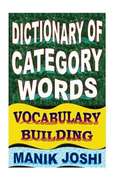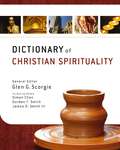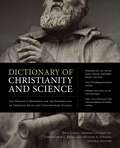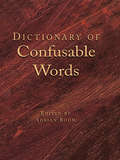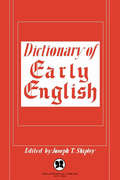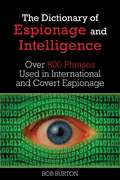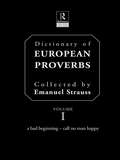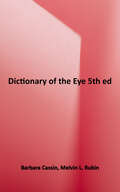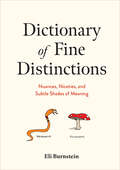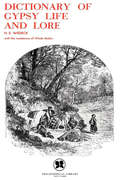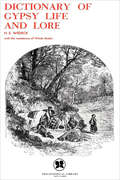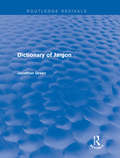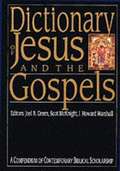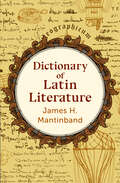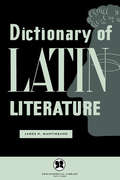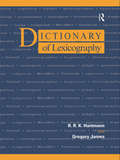- Table View
- List View
Dictionary Activities
by Cindy LeaneyDictionary Activities is a fantastic teaching resource which helps students get to know their dictionaries by explaining dictionary features and how to navigate them. The book also covers more complex topics such as collocations, idioms and wordbuilding. Dictionary Activities also looks at the use of electronic dictionaries and other non-standard specialized dictionaries such as picture dictionaries. In addition to providing over 90 dictionary activities to use in the language classroom, this book is also invaluable to any teacher who wants to improve their own knowledge of how dictionaries work. Dictionary Activities contains eight chapters which deal with: Confidence and dictionary skills-building activities, vocabulary-building activities, grammar activities, pronunciation activities, reading and writing activities, quick activities, CD-ROM and electronic dictionary activities and specialized dictionaries. A wealth of ideas for building dictionary skills in class and making the most of dictionaries as a teaching resource.
Dictionary Of Literary Terms And Literary Theory
by J. A. Cuddon M. A. R. HabibThe Penguin Dictionary of Literary Terms and Literary Theory is firmly established as a key work of reference in the complex and varied field of literary criticism. Now in its fifth edition, it remains the most comprehensive and accessible work of its kind, and is invaluable for students, teachers and general readers alike.
Dictionary Poetics: Toward a Radical Lexicography (Verbal Arts: Studies in Poetics)
by Craig DworkinThe new ways of writing pioneered by the literary avant-garde invite new ways of reading commensurate with their modes of composition. Dictionary Poetics examines one of those modes: book-length poems, from Louis Zukofsky to Harryette Mullen, all structured by particular editions of specific dictionaries. By reading these poems in tandem with their source texts, Dworkin puts paid to the notion that even the most abstract and fragmentary avant-garde literature is nonsensical, meaningless, or impenetrable. When read from the right perspective, passages that at first appear to be discontinuous, irrational, or hopelessly cryptic suddenly appear logically consistent, rationally structured, and thematically coherent.Following a methodology of “critical description,” Dictionary Poetics maps the material surfaces of poems, tracing the networks of signifiers that undergird the more familiar representational schemes with which conventional readings have been traditionally concerned. In the process, this book demonstrates that new ways of reading can yield significant interpretive payoffs, open otherwise unavailable critical insights into the formal and semantic structures of a composition, and transform our understanding of literary texts at their most fundamental levels.
Dictionary of Advertising and Marketing Concepts
by Arthur Asa BergerFrom AdBusters to viral marketing, this brief dictionary of ideas and concepts contains over 100 extended, illuminating entries to bring the novice up to speed on the advertising/marketing world and the ideas that underlie it. For the neophyte professional, it describes the various players and strategies of the industry. For the student, it summarizes the key ideas of the most important cultural theorists introduced in advertising and marketing courses. For everyone, it helps explain the cultural, economic, and psychological role that advertising concepts play in society. A handy introduction for students and a quick reference for young professionals.
Dictionary of Allusions
by Martin H. ManserThis volume nearly doubles an earlier one limited to classical and biblical allusions, drawing as well from Shakespeare, Norse and other mythology, literary texts, historical events, and popular culture including film and television. In addition to explaining what people usually mean when they use the word or phrase and its origin or possible origins, the articles provide an example of its use, a guide for pronouncing any but common English words, and often cross-references to other articles. There is no bibliography. Annotation ©2009 Book News, Inc., Portland, OR (booknews.com)
Dictionary of American Slang
by Barbara Ann Kipfer Robert L. ChapmanThe fourth edition of this authoritative reference offers clear definitions for the slang words and idioms used in everyday American conversation.First published in 1960, this newly updated edition of Dictionary of American Slang traces the language of today back to its American roots. With thousands of entries ranging from the widely accepted to the taboo and obscure, slang words are explained in terms of definition, usage, and historical etymology. As language continues to evolve at an ever-increasing rate, Dictionary of American Slang offers an essential guide to the terms that are here to stay—as well as those that might otherwise be forgotten.
Dictionary of Authentic American Proverbs
by Wolfgang MiederDictionary of Authentic American Proverbs offers a comprehensive reference guide for distinctly American proverbs. Compiled by Wolfgang Mieder, a key figure in the field of proverb studies, this compendium features nearly 1,500 proverbs with American origins, spanning the 17th century to present day, including a scholarly introduction exploring the history of proverbs in America, the structure and variants of these proverbs, known authors and sources, and cultural values expressed in these proverbs. Along with a comprehensive bibliography of proverb collections and interpretive scholarship, this dictionary offers a glimpse into the history of American social and cultural attitudes through uniquely American language.
Dictionary of Biblical Imagery: An Encyclopaedic Exploration Of The Images, Symbols, Motifs, Metaphors, Figures Of Speech, Literary Patterns And Universal Images Of The Bible
by Tremper Longman III Leland Ryken James C. WilhoitChristianity TodayDictionary of Biblical ImageryThe Dictionary of Biblical Imagery
Dictionary of Cape Breton English
by William John Davey Richard P. MackinnonBiff and whiff, baker's fog and lu'sknikn, pie social and milling frolic - these are just a few examples of the distinctive language of Cape Breton Island, where a puck is a forceful blow and a Cape Breton pork pie is filled with dates, not pork.The first regional dictionary devoted to the island's linguistic and cultural history, the Dictionary of Cape Breton English is a fascinating record of the island's rich vocabulary. Dictionary entries include supporting quotations culled from the editors' extensive interviews with Cape Bretoners and considerable study of regional variation, as well as definitions, selected pronunciations, parts of speech, variant forms, related words, sources, and notes, giving the reader in-depth information on every aspect of Cape Breton culture.A substantial and long-awaited work of linguistic research that captures Cape Breton's social, economic, and cultural life through the island's language, the Dictionary of Cape Breton English can be read with interest by Backlanders, Bay byes, and those from away alike.
Dictionary of Category Words: Vocabulary Building (English Word Power #12)
by Manik JoshiDictionary of Category Words: Vocabulary Building (English Word Power) (Volume 12) by Manik Joshi.
Dictionary of Christian Spirituality
by Glen G. Scorgie Gordon T. Smith James D. Smith III Simon ChanIn recent decades Christian spirituality, spiritual formation and spiritual theology have become important concepts in the global evangelical community. Consequently, an accessible and reliable academic resource is needed on these topics—one that will offer a discerning orientation to the wealth of ecumenical resources available while still highlighting the distinct heritage and affirming the core grace-centered values of classic evangelical spirituality. The Dictionary of Christian Spirituality reflects an overarching interpretive framework for evangelical spiritual formation: a holistic and grace-filled spirituality that encompasses relational (connecting), transformational (becoming), and vocational (doing) dynamics. At the same time, contributors respectfully acknowledge the differences between Reformed, Holiness, and Pentecostal paradigms of the spiritual life. And, by bringing together writers from around the world who share a common orthodoxy, this reference work is truly global and international in both its topical scope and contributors. Entries give appropriate attention to concepts, concerns, and formative figures in the evangelical tradition of spirituality that other reference work neglect. They offer a discerning orientation to the wealth of ecumenical resources available, exploring the similarities and differences between Christianity and alternate spiritualities without lapsing into relativism. The Dictionary of Christian Spirituality is a resource that covers a wide range of topics relating to Christian spirituality and is biblically engaged, accessible, and relevant for all contemporary Christians.
Dictionary of Christianity and Science: The Definitive Reference for the Intersection of Christian Faith and Contemporary Science
by Tremper Longman III Christopher L. Reese Michael Strauss Paul CopanThe Dictionary of Christianity and Science provides, in one volume, entries on over 450 key terms, theories, individuals, movements, and debates at the intersection of Christian faith and contemporary science. In addition, because certain topics such as the age of the Earth and the historicity of Adam and Eve provoke disagreement among Christians, the dictionary includes “Counterpoints”-like essays that advocate for the views most commonly held among evangelicals. Representatives of leading perspectives present their arguments vigorously but respectfully in these advocacy essays, allowing readers to compare options and draw their own conclusions. The dictionary is also fully cross-referenced and entries include references and recommendation for further reading. Edited by Paul Copan, Tremper Longman III, Christopher L. Reese, and Michael G. Strauss, the Dictionary of Christianity and Science features a top-notch lineup of over 140 contributors in the fields of biblical studies, theology, philosophy, history, and various sciences. A unique reference work, it will be useful for scholars, pastors, students, and any Christian wanting to better understand the most relevant issues and ideas at the intersection of Christian faith and science.
Dictionary of Confusable Words
by Adrian Room Anne-Lucie NortonFirst Published in 2000. Routledge is an imprint of Taylor & Francis, an informa company.
Dictionary of Early English
by Joseph T. ShipleyJoseph T. Shipley's tome Dictionary of Early English provides an indispensible and unparalleled reference tool on the study of early English. With a preface by Mark Van Doren and an extensive headword list, this dictionary brings to light the terms, concepts, and vocabulary of ancient English. Joseph T. Shipley has written and edited several books, dictionaries, and anthologies including The Origins of English Words, Modern French Poetry, An Anthology, and Dictionary of World Literature.
Dictionary of Espionage and Intelligence: Over 800 Phrases Used in International and Covert Espionage
by Bob Burton W. E. GriffinFrom Bob Burton - a former member of both the civilian and military intelligence communities and America’s most feared bounty hunter - comes the complete lexicon of over 800 terms and meanings used in international and covert espionage. Dictionary of Espionage and Intelligence includes the most up-to-date terminology of special operations from A to Z, including: Breaktime: The time it takes to break down he resistance level of a subject in an interrogation of a brutal nature - usually 5-7 hours Hero Project: A project, operation, or extraction considered too dangerous, with only the most skilled personnel able to pull it off. Cake or Death: An unspoken but soon-realized ultimatum that a prisoner of the spook war understands as his personal fate - cooperate or die.Compiled by a man who knows covert action and clandestine warfare from the inside out, Dictionary of Espionage and Intelligence is a perfect compendium of the secret language spoken by those who fight the silent war.
Dictionary of European Proverbs
by Emanuel StraussThis Dictionary contains over 50,000 proverbs, in some 70 European languages and dialects, arranged in 2,500 sets. It is the fruits of over 40 years of collection and research, the only collection of proverbs on anything like this scale ever to be published anywhere in the world. Emanuel Strauss has trawled through innumerable collections of proverbs in all languages, from early printed books and rare items to the latest theses and journals, and grouped together many thousands of proverbs in sets of equivalent meaning. Comprehensive indexes for each language provide access to any proverb by way of its key words. A critical bibliography musters some 500 items, from incunabula to the current decade.
Dictionary of Eye Terminology
by Barbara CassinPocket-sized dictionary of ophthalmic terminology, for ophthalmology residents, optometry students, and medical students. Features coverage of acronyms, synonyms, commonly misspelled words, and pronunciation. Extensively cross-referenced. Previous edition: c1996. Wire-spiral bound. DNLM: Ophthalmology--dictionaries.
Dictionary of Fine Distinctions: Nuances, Niceties, and Subtle Shades of Meaning
by Eli Burnstein"This delightful book is a tribute to the genius of the human mind for conceptual precision and the beauty of the English language in capturing it. It resolves a great deal of puzzlement over confusable terms, and its endearing illustrations and lighthearted explanations multiply the satisfaction." —Steven Pinker, author of The Language Instinct and Rationality What&’s the difference between mazes and labyrinths? Proverbs and adages? Clementines and tangerines? Join author Eli Burnstein on a hairsplitter&’s odyssey into the world of the ultra-subtle with Dictionary of Fine Distinctions. Illustrated by New Yorker cartoonist Liana Finck, this humorous dictionary takes a neurotic, brain-tickling plunge into the infinite (and infinitesimal) nuances that make up our world. The perfect gift for book lovers, word nerds, trivia geeks, and everyday readers, this illustrated gem is more than just a book—it is an indispensable resource akin to a thesaurus but filled with charm and wit. Each entry, from &“latte vs. flat white" to &“Great Britain vs. The United Kingdom," is accompanied by mnemonic aids, quirky asides, and detailed illustrations, making it a standout dictionary for any bibliophile or language enthusiast's library.For fans of The Dictionary of Obscure Sorrows or Foyle's Philavery: A Treasury of Unusual Words, Dictionary of Fine Distinctions promises to be a cherished addition to the genre that offers clarity, joy, and a deeper appreciation for the subtleties of the English language. The quintessential librarian gift and English teacher gift, it&’s an educational odyssey that&’s as entertaining as it is enlightening.
Dictionary of Gypsy Life and Lore
by Wade Baskin Harry E WedeckThrough the centuries, Gypsies all over the world have been misunderstood, maligned, rejected. Outcasts of the countries in which they live, they have wandered for centuries over the face of the earth. They have no homeland, no political unity, no recognition among nations. They have been alone, sundered, shunned, persecuted and banished. Until about a century ago, their original home had been a matter of dispute. Their language had been a source of puzzlement. Yet their conduct and their traditions, their feeling for music, dance and song, have all been acclaimed. Still they were not accepted and were forced to remain apart from conventional society. Here is their epic history, with its folktales and beliefs, its rites and customs. Here is the vast treasury of the Gypsies.
Dictionary of Gypsy Life and Lore
by Wade Baskin Harry E. WedeckThis comprehensive reference volume offers in-depth information on one of the world&’s most fascinating and misunderstood cultures. Throughout history, Gypsies all over the world have been maligned and rejected. Outcasts of the countries in which they live, these nomads have wandered for years over the face of the earth. They have no homeland, no political unity, no recognition among nations. In popular folklore, they are vagrants, thieves, tinkerers, and con artists, which is to say, egregiously misunderstood. Until about a century ago, these travelers&’ original home had been a matter of dispute. Their language had been a source of puzzlement. Yet their conduct and their traditions, their feeling for music, dance and song, have all been acclaimed. Harry Wedeck&’s Dictionary of Gypsy Life and Lore sheds much-needed light on the true history and culture of the Gypsies, separating fact from fiction while celebrating their folktales, rites, and customs.
Dictionary of Jargon: A Dictionary Of Jargon (Routledge Revivals)
by Jonathon GreenFirst published in 1987, the Dictionary of Jargon expands on its predecessor Newspeak (Routledge Revivals, 2014) as an authoritative reference guide to specialist occupational slang, or jargon. Containing around 21, 000 entries, the dictionary encompasses a truly eclectic range of fields and includes extensive coverage of both British and U.S. jargon. Areas dealt with range from marketing to medicine, from advertising to artificial intelligence and from skiing to sociology. This is a fascinating resource for students of lexicography and professional lexicographers, as well as the general inquisitive reader.
Dictionary of Jesus and the Gospels: A Compendium of Contemporary Biblical Scholarship
by Scot Mcknight Joel B. Green I. Howard MarshallRecipient of a Christianity Today1993 Critics Choice Award! Third Place Winner of Christianity Today's Book of the Year list award! The Dictionary of Jesus and the Gospels is unique among reference books on the Bible, the first volume of its kind since James Hastings published his Dictionary of Christ and the Gospels in 1909. In the more than eight decades since Hastings our understanding of Jesus, the Evangelists and their world has grown remarkably. New interpretive methods have illumined the text, the ever-changing profile of modern culture has put new questions to the Gospels, and our understanding of the Judaism of Jesus' day has advanced in ways that could not have been predicted in Hasting's day. But for many readers of the Gospels the new outlook on the Gospels remains hidden within technical journals and academic monographs. The Dictionary of Jesus and the Gospels bridges the gap between scholars and those pastors, teachers, students and lay people desiring in-depth treatment of select topics in an accessible and summary format. The topics range from cross-sectional themes (such as faith, law, Sabbath) to methods of interpretation (such as form criticism, redaction criticism, and death of Jesus) to each of the four Gospels as a whole. Some articles--such as the Dead Sea Scrolls, rabbinic traditions and revolutionary movements at the time of Jesus--provide significant background information to the Gospels.
Dictionary of Latin Literature
by James H MantinbandDiscover the essential works of Latin literary masters with this A-to-Z reference guide spanning from ancient Rome to the Renaissance. In Dictionary of Latin Literature, classics scholar and translator James H. Mantinband provides students and curious readers with an authoritative, accessible, and wide-ranging reference book. It includes detailed entries on significant works and authors as well as important terms and concepts. Covering the history of Latin literature from the early Roman Republic to the Middle Ages and the Renaissance, this single volume offers a treasure trove of fascinating information.
Dictionary of Latin Literature
by James H. MantinbandJames H. Mantinband's Dictionary of Latin Literature introduces readers to the essential works of the Latin masters. An excellent tool for students and curious readers alike, this dictionary provides guides to the original works and their modern criticisms. An expert in Greek and Latin literature, James H. Mantinband has written and edited dictionaries and reference works on the subjects including Concise Dictionary of Greek Literature, Dictionary of Latin Literature, and Dictionary of Greek Literature. He has also translated several classic plays including Four plays of Aristophanes: The clouds, The birds, Lysistrata, The frogs.
Dictionary of Lexicography
by R. R. Hartmann Gregory JamesDictionaries are among the most frequently consulted books, yet we know remarkably little about them. Who makes them? Where do they come from? What do they offer? How can we evaluate them?The Dictionary of Lexicography provides answers to all these questions and addresses a wide range of issues:* the traditions of dictionary-making* the different types of dictionaries and other reference works (such as thesaurus, encyclopedia, atlas and telephone directory)* the principles and concerns of lexicographers and other reference professionals* the standards of dictionary criticism and dictionary use.It is both a professional handbook and an easy-to-use reference work.This is the first time that the subject has been covered in such a comprehensive manner in the form of a reference book. All articles are self-contained, cross-referenced and uniformly structured. The whole is an up-to-date and forward-looking survey of lexicography.
